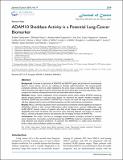ADAM10 Sheddase Activity is a Potential Lung-Cancer Biomarker
Author(s)
Yoneyama, Toshie; Gorry, Michael; Sobo-Vujanovic, Andrea; Lin, Yan; Vujanovic, Lazar; Gaither-Davis, Autumn; Moss, Marcia L.; Stabile, Laura P.; Herman, James; Vujanovic, Nikola L.; Miller, Miles Aaron; Griffith, Linda G; Lauffenburger, Douglas A; ... Show more Show less
Downloadv09p2559.pdf (1022.Kb)
PUBLISHER_CC
Publisher with Creative Commons License
Creative Commons Attribution
Terms of use
Metadata
Show full item recordAbstract
Background: Increases in expression of ADAM10 and ADAM17 genes and proteins are inconsistently found in cancer lesions, and are not validated as clinically useful biomarkers. The enzyme-specific proteolytic activities, which are solely mediated by the active mature enzymes, directly reflect enzyme cellular functions and might be superior biomarkers than the enzyme gene or protein expressions, which comprise the inactive proenzymes and active and inactivated mature enzymes. Methods: Using a recent modification of the proteolytic activity matrix analysis (PrAMA) measuring specific enzyme activities in cell and tissue lysates, we examined the specific sheddase activities of ADAM10 (ADAM10sa) and ADAM17 (ADAM17sa) in human non-small cell lung-carcinoma (NSCLC) cell lines, patient primary tumors and blood exosomes, and the noncancerous counterparts. Results: NSCLC cell lines and patient tumors and exosomes consistently showed significant increases of ADAM10sa relative to their normal, inflammatory and/or benign-tumor controls. Additionally, stage IA-IIB NSCLC primary tumors of patients who died of the disease exhibited greater increases of ADAM10sa than those of patients who survived 5 years following diagnosis and surgery. In contrast, NSCLC cell lines and patient tumors and exosomes did not display increases of ADAM17sa. Conclusions: This study is the first to investigate enzyme-specific proteolytic activities as potential cancer biomarkers. It provides a proof-of-concept that ADAM10sa could be a biomarker for NSCLC early detection and outcome prediction. To ascertain that ADAM10sa is a useful cancer biomarker, further robust clinical validation studies are needed.
Date issued
2018-06Department
Massachusetts Institute of Technology. Biotechnology Process Engineering Center; Massachusetts Institute of Technology. Department of Biological Engineering; Massachusetts Institute of Technology. Department of Biology; Massachusetts Institute of Technology. Department of Chemical Engineering; Massachusetts Institute of Technology. Department of Mechanical EngineeringJournal
Journal of Cancer
Publisher
Ivyspring International Publisher
Citation
Yoneyama, Toshie, Michael Gorry, Andrea Sobo-Vujanovic, Yan Lin, Lazar Vujanovic, Autumn Gaither-Davis, Marcia L. Moss, et al. “ADAM10 Sheddase Activity Is a Potential Lung-Cancer Biomarker.” Journal of Cancer 9, no. 14 (2018): 2559–2570.
Version: Final published version
ISSN
1837-9664